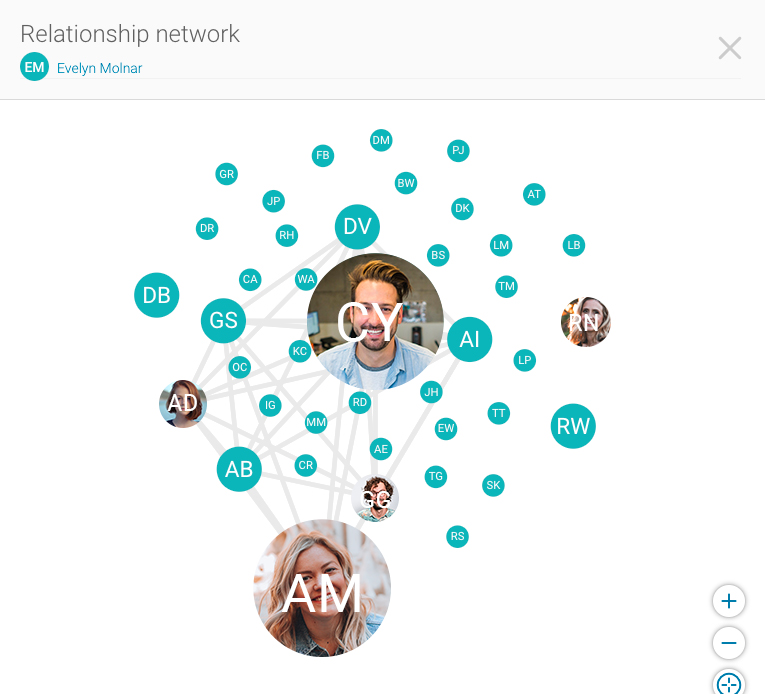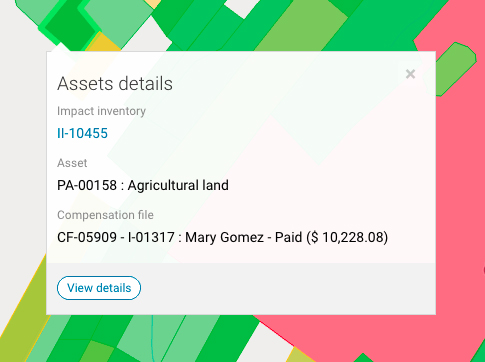Take a look inside any large company that develops infrastructure projects and you’re bound to find a number of departments that are required to engage with stakeholders: community relations, public affairs and government relations, land and permits, and media relations.
While these departments all fill different roles and adhere to different processes, they essentially share the same objective: securing social acceptance and stakeholder buy-in so that infrastructure projects can move forward without undue costs or delays.
How silos lead to dangerous stakeholder blind spots
One of the biggest issues all large companies grapple with is ensuring that the necessary information is readily available to the right people. All organizations understand that having a 360 degree view of stakeholders that’s free of blind spots will vastly improve their stakeholder engagement outcomes. But where they often fall short is in their ability to share stakeholder information across multiple departments.
Take our hypothetical infrastructure project as an example. Let’s say the Media Relations team contacts a stakeholder because he has expressed a negative opinion about the company’s proposed infrastructure project. But what if this same stakeholder also happens to be simultaneously negotiating property access rights with the company’s Land and Permits team? The Media Relations team would certainly stand to gain from having access to the information collected by the Land and Permits team and vice versa. This additional information would allow for more accurate stakeholder mapping and analysis, resulting in a clearer sense of this particular stakeholder’s influence, power and interest. In fact, approaching this stakeholder without all this valuable knowledge in hand could potentially be embarrassing. Not to mention ineffective for building a productive relationship.
How to break down silos with Borealis and keep the information flowing
Anyone who works for a large organization knows that the best way to break down silos is to keep information flowing freely between departments. But this can be easier said than done. Individual teams can’t always see the value of sharing their hard-gained information with other teams. The “what’s in it for me?” mentality can be a major barrier to collaboration.
During a global pandemic with enforced social distancing, the loss of all those impromptu water cooler meetings can mean even bigger silos.
One easy way to bypass this resistance to sharing knowledge is to have all teams work on the same information management system. That way, everyone is feeding information into the same system, and anyone with access rights – regardless of department – can access all data that has been inputted into the system – regardless of who collected or entered it into the system.
In other words, the system becomes the guardian of the information rather than the individual departments that initially collected it. This democratization of data can be a game changer for outcomes. Everyone benefits from everyone else’s knowledge – without involving any extra effort, internal conflicts or power struggles.
Benefits of using an information management system to manage stakeholder data
- Keeping information centralized and available according to access levels makes it easier to standardize stakeholder communications, ensure grievances are handled diligently and efficiently, and avoid being blindsided.
- It fosters collaboration organically.
- It allows individual teams and team members to take advantage of the stakeholder intelligence obtained from other departments to strengthen their own relationships with stakeholders.
- Having all stakeholder information stored in a single location means more complete records – not only for your current project, but for future projects as well.
- Better intelligence makes stakeholders easier to map and analyze with greater accuracy.
Example of how Borealis software breaks down silos
A minister of transportation must give his approval for your planned light rail project that will link three municipalities. The train’s route will pass near a seniors’ residence where a relative of the minister lives. Some local community members are already complaining that the rail’s construction will generate a lot of dust and possibly more traffic. Meanwhile, your Land and Permits team will also need to negotiate with the seniors’ residence, because it plans to turn part of the home’s parking lot into a Park and Ride (incentive parking) lot.
From a political standpoint, the minister agrees with the project, but the green light is long overdue. The Community Relations team is diligently entering complaints from the seniors’ home into Borealis. Meanwhile, the Media Relations team, which is closely following what the minister is saying about the project on Twitter, detects some reluctance – particularly with respect to the fact that the rail will pass so closely to a seniors’ home.
The Media Relations team enters this information into Borealis, where it becomes immediately available to the Government Affairs team. With this additional knowledge, the team is better able tp address this issue with the Minister and reassure him. The results of that conversation are then entered into Borealis by the Government Affairs team, and used by the Media Relations team to quickly put together a communications plan to properly inform local residents about the measures that will be put in place to lessen the perceived negative impacts of the project’s construction.
Meanwhile, the Land and Permits team also has access to this information and is making good use of it by modifying its strategy for negotiating parking access
How Borealis makes life easier for individual teams working with stakeholders
Borealis software democratizes stakeholder information so that it’s available to all interested departments. Individual teams can also configure the system with specific views and dashboards so that the information that’s most useful to them remains front and center. If a team needs a more global view or additional context, users can easily can drill down, generate reports, etc.
Here’s how Borealis’ silo-free approach can make life easier for the individual departments working on an infrastructure project.

Community Relations
The main objective of a Community Relations team is to build and maintain positive and sustainable relationships with key community stakeholders – whether they’re individuals, groups or organizations. Borealis makes this task easier by allowing them to:
- Understand the affiliations of key community stakeholders involved in different associations.
- Analyze the trends of emerging topics in the project’s geographic zones.
- Access details of interactions with specific stakeholders, including written communications, face-to-face meetings, grievances received, issues raised and commitments made.
That’s just the beginning.

Media Relations
Media Relations teams are entrusted with controlling the messages surrounding a project. This includes anything the organization itself has to say about the project as well as what others are saying – whether it’s in a press release, a newspaper article or a social media post. Borealis makes this task easier by allowing these teams to:
- Easily add press reviews to Borealis. The system’s AI tools automatically detect stakeholders mentioned to easily link those to the stakeholder profiles. The Relationship Manager can then be notified whenever one of his or her stakeholders is mentioned in the news.
- Follow influencers on Twitter and automatically have their mentions of the project created as a communications in Borealis for reporting purposes – and easily add this information to the stakeholder’s profile in Borealis.
- Categorize whether mentions about the project are positive or negative in order to detect trends according to topic, journalist, media group, etc.
These are just two examples of how Borealis can improve media relations.

Public Relations and Government Affairs
Public Relations and Government Affairs teams are responsible for clearing the legislative path for things like permits, access rights and more. This is done by carefully building productive relationships with elected and government officials and others who shape public policy. Borealis makes this task easier by allowing these teams to:
- Connect stakeholder engagements or communications to geographical locations and assets, in addition to just individuals.
- Create an institutional memory that outlives the tenure of elected officials, or even in-house team members.
- Keep sensitive information hidden or on a need-to-know basis.
- Use the Relationship network to better understand the complex interconnected relationships of key stakeholders and their influence on one another.


Land and Permits or Real Estate
Land and Permits teams handle the purchase and management of any real estate or access rights linked to an infrastructure project. Borealis makes this task easier by allowing them to:
- Connect route and infrastructure maps to land parcels to identify land owners and visualize how they are impacted by the project.
- See at a glance if a given landowner appears multiple times along a project’s planned route – including on routes spanning several municipalities – to detect priority stakeholders.
- Know the details of ongoing discussions with each stakeholder, regardless of which team member was involved.

Why breaking down the silo mentality is so important in stakeholder management
The instinct to hoard one’s hard-earned valuable stakeholder information may not be laudable, but it’s certainly understandable – at least to some degree. After all, knowledge is power. But this resistance to share information will only work against everyone’s benefit in the long run – including the person safeguarding the information.
Silos aren’t built in a day. They often grow over time as a result of poor communication, misunderstandings and a lack of awareness. When left unresolved, these issues can evolve into a deep-set unwillingness to cooperate – airtight silos, so to speak.
Power struggles, lack of trust, organizational inefficiency and lost opportunities are all signs of silos at work. Such dynamics translate into an inability to make informed decisions driven by data.
Breaking down silos: The onus is on the executive and management team
Silos are a top-down phenomenon. Look inside any silo and chances are you’ll find a conflicted leadership team. Since a silo mentality cannot exist without the implicit buy-in of the leadership team, it is their responsibility to dismantle it. Any reluctance to do so will only undermine the overall health of the organization.
That being said, executives may be reluctant to acknowledge their role in creating and maintaining a silo mentality. It’s not uncommon for executives to attribute departmental inefficiencies and a lack of cross-functional solutions to employee inexperience, undertraining or a mere unwillingness to “work together”.
Executives who fail to take concrete steps to remedy departmental inefficiencies are only harming the organization. In the short term, maintaining a dysfunctional status-quo will lead to understandable frustration, resentment and cynicism among teams. In the long term, it will lead to chronic underperformance.
Executives must be willing to recognize the existence of silos. They must also be willing to equip their teams with the proper tools and mindset to break these destructive organizational barriers.
There are number of effective strategies for breaking down the silo mentality. Eliminating the division of information with a centralized information management system such as a stakeholder engagement management platform is one relatively easy and concrete step an executive team can take. Above and beyond bringing immediate and lasting benefits to day-to-day interdepartmental collaboration, this type of system will also help to change the corporate culture gently and organically from within.
By democratizing stakeholder information, departments will be better able to:
- Collaborate effectively.
- Understand each other’s contributions to achieving the organization’s goals.
- Value each other’s input, making for a more productive and efficient workplace.
- Complete tasks on schedule and to a higher standard.
- Improve team morale and the willingness to “pitch in” when required.
- Contribute to more successful stakeholder engagement outcomes.
As any team captain will tell you, the best way to win is by having everyone rowing fiercely in the same boat – and in the same direction.





